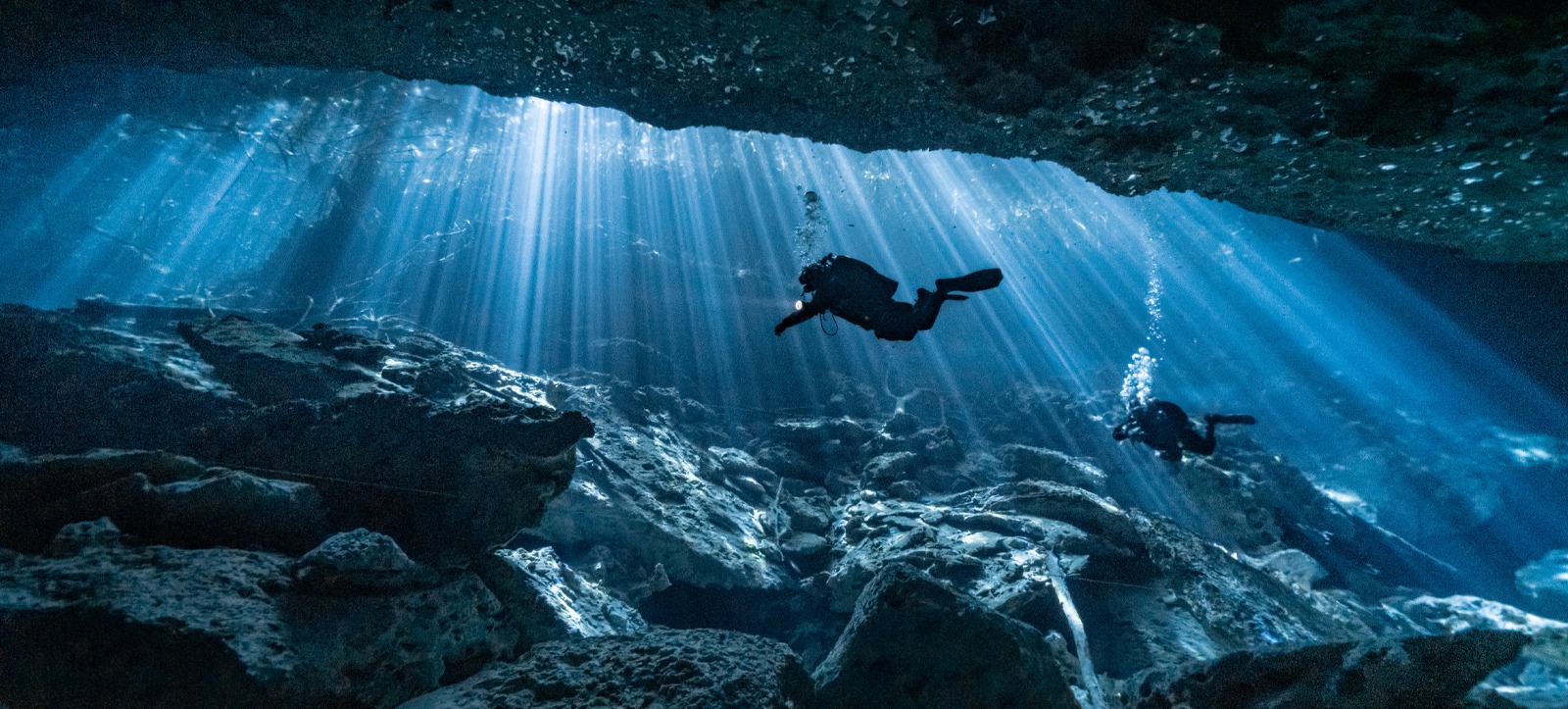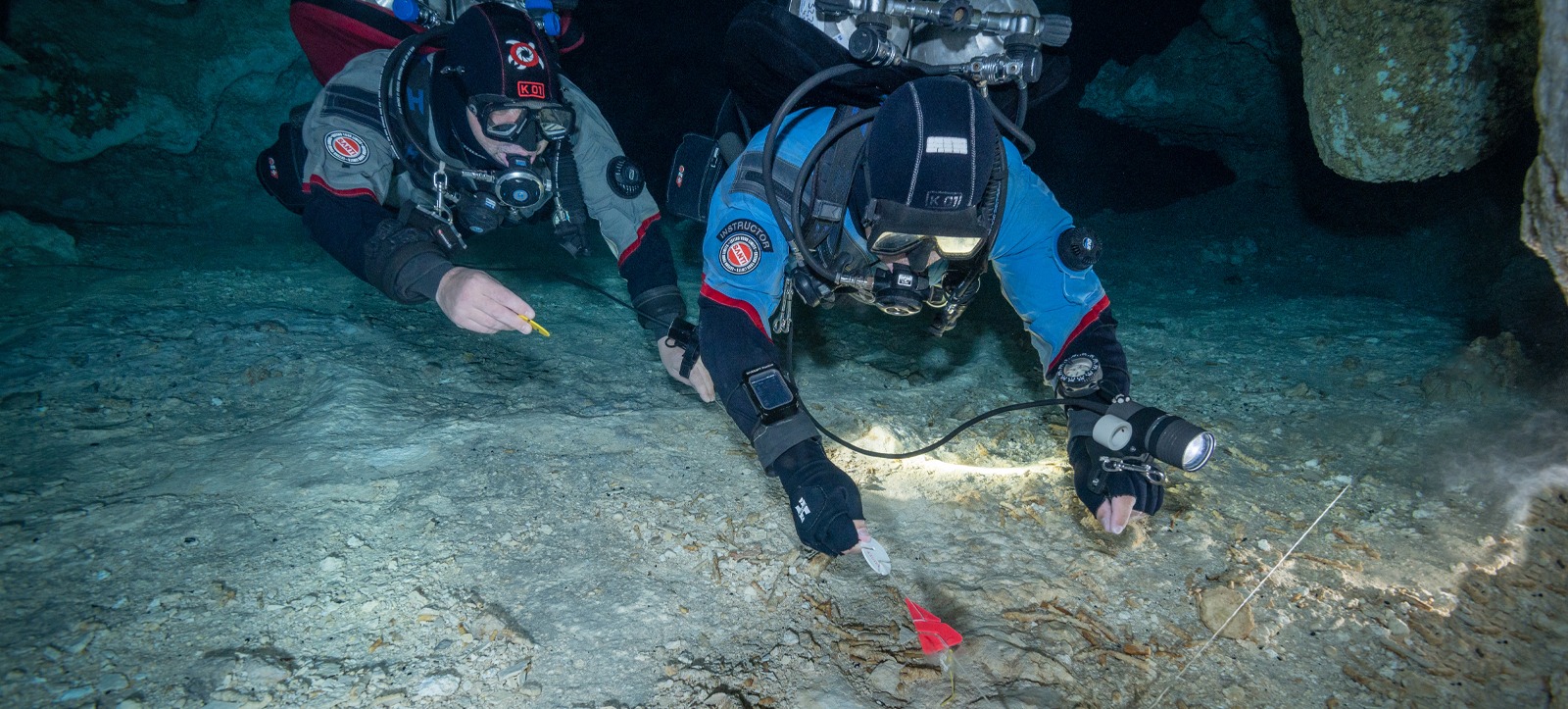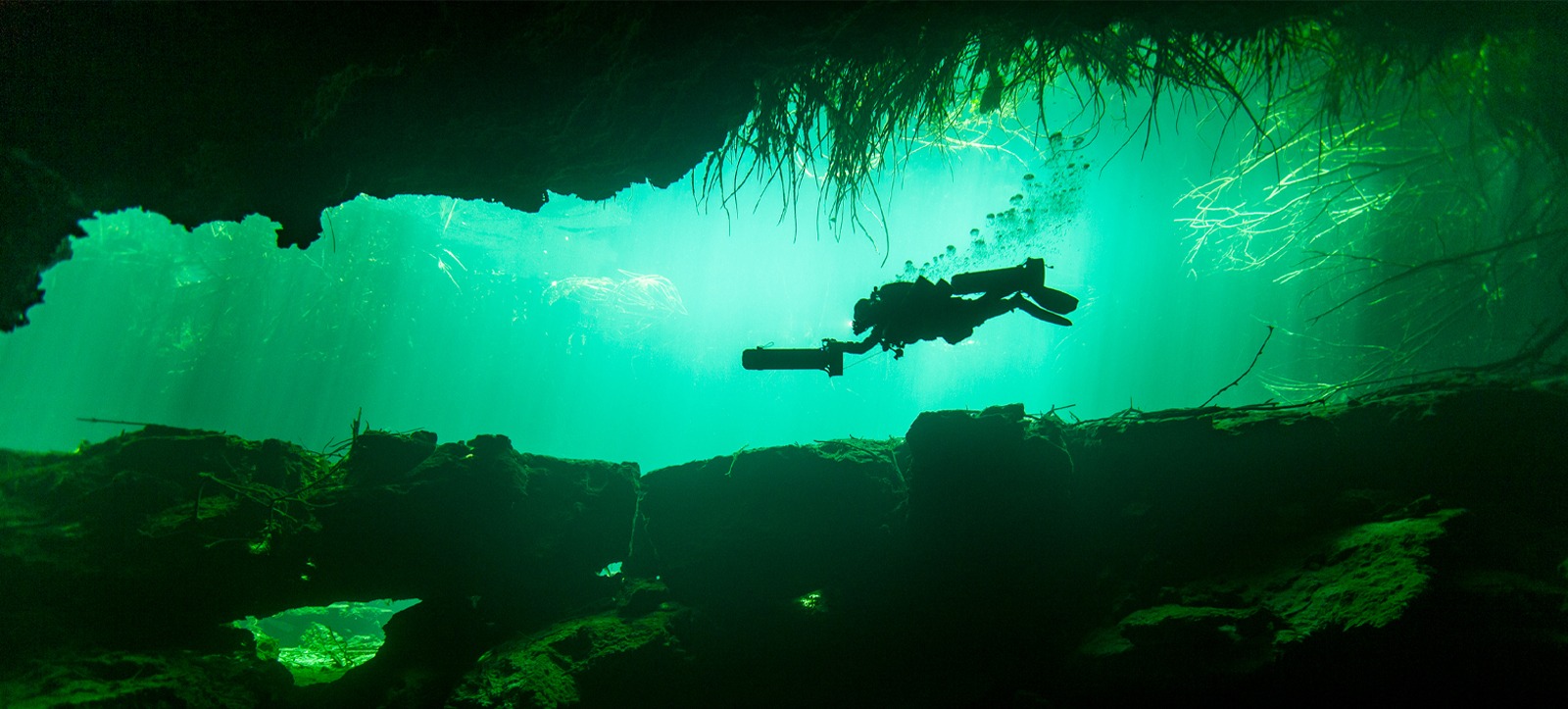Cavern Diver
Introduction
The IANTD Cavern Diver course is a type of scuba diving certification focused on exploring overhead environments and it serves as an intermediate step between recreational and technical diving. Caverns are partially overhead environments with a visible daylight zone — meaning you can always see the entrance or exit. This is an advanced open water diver on overhead diving entry level with the required knowledge and skills for using and applying the appropriate equipment and procedures to safely plan and execute dives in a cavern zone of a cave. This class can be taught in singl tank, double tanks or sidemount configuration.
What You Will Learn
• planning and executing dives in cavern zones
• proper use of guide lines as reels, spools and line-handling skills
• buoyancy control in confined spaces
• use of redundant equipment as back-up lights and gas supply
• emergency procedures as silt-out situations, line entanglements and light failures
Course Requirements
• minimum 16 years old
• IANTD Advanced Open Water Diver or equivalent
• IANTD Open Water Sidemount Diver or equivalent (only in case of sidemount configuration usage)
• 50+ dives
• 10+ night dives
• 10+ dives with double tanks or sidemount (only in case of double tanks or sidemount configuration usage)
• all participants must be able to swim at least 270 meters (300 yards) in 14 minutes
• all participants must be able to swim a distance of at least 12 meters (40 feet) on a breath hold
• valid DAN World insurance or equivalent
Minimum Course Duration
• 3 days
Minimum Dives Required
• 4 cavern dives
Course Limits
• maximum 3 students per 1 instructor
• air or nitrox may be used, depends on diver certification level
• unobstructed exit, surface and/or natural light must be always visible
• dives with maximum of 60 meters from the nearest exit
• maximum 1/3 gas rule for penetration
• maximum depth 30 meters (100 feet)
• minimum 12 meters (40 feet) of visibility to enter a cavern zone
• all dives are to maintain a working PPO2 of no grater than 1,4 ATA
• cavern line only, no jumps/gaps, no intersections [ T’s ], no restrictions, no planned decompression, no scooter or rebreather diving, no photo/video dives, no stage cylinders, no solo diving
Introductory Cave Diver
Introduction
The IANTD Introductory Cave Diver course, also known as “Intro to Cave,” is a technical diving course designed to train divers in the basic skills and protocols for safely entering and navigating underwater caves. This class is designed for more experienced divers and focuses on proper use of required equipment, as well as safely planning and conducting dives in an overhead environment while staying on the main line of the cave. This class can be taught in double tanks or sidemount configuration.
What You Will Learn
• planning and executing introductory cave dives
• gas management for overhead environment
• proper line following techniques and emergency line drills
• basic cave navigation using permanent line
• gas sharing scenarios in confined and dark spaces
• zero visibility exits
• stress management and team diving protocols in overhead environment
Course Requirements
• minimum 18 years old
• IANTD Advanced Open Water Diver or equivalent
• IANTD Open Water Sidemount Diver (only in case of sidemount configuration usage)
• IANTD Cavern Diver or equivalent (only in case of independent Introductory Cave Diver course)
• 75+ dives
• 25+ dives with double tanks or sidemount, depends on which configuration is used
• 10+ night dives
• all participants must be able to swim at least 270 meters (300 yards) in 14 minutes
• all participants must be able to swim a distance of at least 12 meters (40 feet) on a breath hold
• valid DAN World insurance or equivalent
Minimum Course Duration
• 4 days
Minimum Dives Required
• 6 cave dives (Introductory Cave Diver)
• 10 dives in overhead environment (Cavern Diver + Introductory Cave Diver)
Course Limits
• maximum 3 students per 1 instructor
• air or nitrox may be used, depends on diver certification level
• maximum 1/6 gas rule for cave penetration
• maximum depth 30 meters (100 feet)
• minimum 9 meters (30 feet) of visibility to enter a cave
• all dives are to maintain a working PPO2 of no grater than 1,4 ATA
• main line only, no complex navigation (jumps/gaps, intersections [ T’s ], traverses, circuits), no restrictions, no planned decompression, no scooter or rebreather diving, no exploration, no photo/video dives, no stage cylinders, no solo diving
Cave/Technical Cave Diver
Introduction
The IANTD Cave Diver course, also known as “Full Cave Diver,” is the core certification for those who want to dive complex cave systems. It is intended for highly experienced divers operating at the highest level of competence, with the knowledge and skills required to properly plan and safely execute dives in the complex cave environment. The Technical Cave Diver course is an identical class, but it enables divers to plan decompression dives and use decompression cylinders. Both classes can be taught in double tanks or sidemount configuration.
What You Will Learn
• planning and executing cave dives with complex navigation
• more advanced dive planning and gas management
• emergency protocols as lost line, lost diver, out of gas situations, broken line, etc.
• advanced cave navigation with restrictions
• more silt-out and zero visibility procedures, also in restrictions
• psychological resilience and problem solving
• understanding complex cave systems and hazards
Course Requirements
• minimum 18 years old
• IANTD Advanced Open Water Diver or equivalent
• IANTD Open Water Sidemount Diver (only in case of sidemount configuration usage)
• IANTD Introductory Cave Diver or equivalent (only in case of independent Cave Diver course)
• IANTD Advanced EANx Diver or equivalent (only in case of Technical Cave Diver course)
• 100+ dives
• 25+ dives with double tanks or sidemount, depends on which configuration is used
• 10+ night dives
• all participants must be able to swim at least 270 meters (300 yards) in 14 minutes
• all participants must be able to swim a distance of at least 12 meters (40 feet) on a breath hold
• valid DAN World insurance or equivalent
Minimum Course Duration
• 4 days (Cave Diver)
• 7 days (Introductory Cave Diver + Cave Diver)
• 9 days (complete Full Cave Diver course)
Minimum Dives Requires
• 6 cave dives (Cave Diver)
• 12 cave dives (Introductory Cave Diver + Cave Diver)
• 16 dives in overhead environment (complete Full Cave Diver course)
Course Limits
• maximum 3 students per 1 instructor
• air or nitrox may be used, depends on diver certification level
• maximum 1/3 gas rule for cave penetration
• maximum depth 30 meters (100 feet)
• minimum 6 meters (20 feet) of visibility to enter a cave
• all dives are to maintain a working PPO2 of no grater than 1,4 ATA
• complex navigation (jumps/gaps, intersections [ T’s ], traverses, circuits) and restrictions are allowed
• decompression cylinders and/or planned decompression may be used during Technical Cave Diver course
• no scooter or rebreather diving, no exploration, no photo/video dives, no solo diving
Advanced Cave – Stage Diver
Introduction
The IANTD Advanced Cave – Stage/Multiple Stage Diver is an advanced level cave diving course that teaches experienced certified cave divers how to use stage cylinders to extend their penetration distance and/or bottom time, while maintaining safety in a complex overhead environment. This class can be taught in double tanks or sidemount configuration.
What You Will Learn
• dive planning for extended range penetrations
• stage gas management for overhead environment
• proper rigging of stage bottles for cave diving
• stage procedures as drop/pick-up, gas switch and restrictions
• redundancy and contingency planning with stages
• emergency procedures with multiple gas sources
• zero visibility procedures with stages
• understanding more complex gas planning
Course Requirements
• minimum 18 years old
• IANTD Cave/Technical Cave Diver or equivalent
• IANTD Open Water Sidemount Diver (only in case of sidemount configuration usage)
• 25+ cave dives
• 10+ dives with stage/decompression cylinders
• all participants must be able to swim at least 270 meters (300 yards) in 14 minutes
• all participants must be able to swim a distance of at least 12 meters (40 feet) on a breath hold
• valid DAN World insurance or equivalent
Minimum Course Duration
• 4 days
Minimum Dives Required
• 4 cave dives using stage cylinders
Course Limits
• maximum 3 students per 1 instructor
• air or nitrox may be used, depends on diver certification level
• maximum 1/3 gas rule of total gas for cave penetration
• maximum depth 30 meters (100 feet)
• minimum 6 meters (20 feet) of visibility to enter a cave
• all dives are to maintain a working PPO2 of no grater than 1,4 ATA
• complex navigation (jumps/gaps, intersections [ T’s ], traverses, circuits) and restrictions are allowed
• planned decompression may be used
• no rebreather diving, no exploration, no photo/video dives, no solo diving
Advanced Cave – DPV Diver
Introduction
The IANTD Advanced Cave – DPV Diver is a specialized, advanced course that trains very experienced certified cave divers in the use of Diver Propulsion Vehicles (underwater scooters) for penetration into complex cave systems. It is designed to extend the range, efficiency, and mobility in larger cave passages while managing the risks that come with adding this powerful tool. This class can be taught in double tanks or sidemount configuration.
What You Will Learn
• advanced gas planning for extended range scooter dives
• DPV mechanics and cave-specific setup
• turn pressure and bailout calculations with scooter use
• risk analysis of DPV malfunctions deep in a cave
• navigation techniques at higher speeds in overhead environment
• failure scenarios as diver and DPV towing, out of gas, gas sharing while scootering, etc.
• managing multiple stage cylinders while scootering
• back-up DPV towing
• scooter stowage and retrieval underwater
Course Requirements
• minimum 18 years old
• IANTD Technical Cave Diver and/or Stage Cave Diver or equivalent
• IANTD Open Water Sidemount Diver (only in case of sidemount configuration usage)
• 50+ cave dives
• 25+ dives with stage/decompression cylinders
• 25+ dives with DPV
• all participants must be able to swim at least 270 meters (300 yards) in 14 minutes
• all participants must be able to swim a distance of at least 12 meters (40 feet) on a breath hold
• valid DAN World insurance or equivalent
Minimum Course Duration
• 5 days
Minimum Dives Required
• 5 cave dives using DPV’s
Course Limits
• maximum 2 students per 1 instructor
• air or nitrox may be used, depends on diver certification level
• specific gas management for cave penetration using DPV’s
• maximum depth 30 meters (100 feet)
• minimum 6 meters (20 feet) of visibility to enter a cave
• all dives are to maintain a working PPO2 of no grater than 1,4 ATA
• complex navigation (jumps/gaps, intersections [ T’s ], traverses, circuits) and restrictions are allowed
• stage cylinders and planned decompression may be used
• no rebreather diving, no exploration, no photo/video dives, no solo diving






